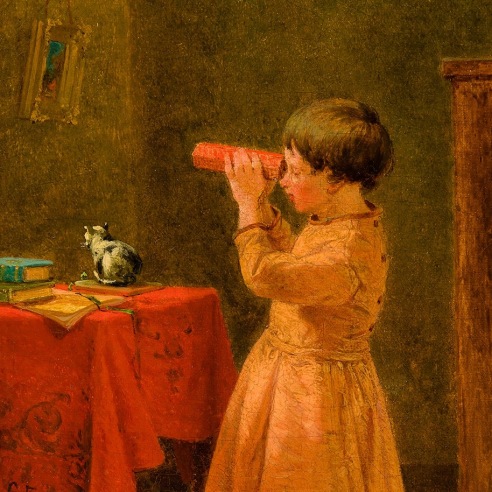
In April 1847, Charles Blauvelt made his professional debut at the Annual Exhibition of the National Academy of Design, showing a genre scene appropriately named The Arrival. The painting heralded what would be a long career for this artist, lasting until his death in Greenwich, Connecticut, in 1910. Exhibition records document Blauvelt’s successful career as a genre painter in late-nineteenth century America. Information, however, with regard to the artist’s early life remains sparse and contradictory.
The details of Charls Blauvelt’s life come into clearer focus in 1844, when the 20-year-old enrolled in the antique class at the school of the National Academy of Design. First identified as a “coach painter,” Blauvelt studied at the school in 1845–46, and again in 1847–49, progressing in the school’s description from “intended portrait painter” to “portrait painter.” He may have studied “colors” with the well-known portraitist Charles Loring Elliot (1812–1868). In 1848, Blauvelt succeeded in selling two paintings to the American Art-Union for their annual lottery distribution. The Art-Union continued as a patron buying offering three works in 1849, three in 1850 and one at its final auction sale in 1852. Blauvelt’s exhibition venues included the National Academy of Design, New York (20 paintings from 1847 through 1880); the Philadelphia Academy of the Fine Arts (8 paintings between 1862 and 1869); as well as occasional submissions to the Brooklyn Art Association (1861, 1866, and 1871), the Boston Athenaeum (1859, 1871) and the Washington Art Association (1857). His most active period of exhibition were the decades of the 1850s and 1860s. In 1857, Blauvelt was elected an associate member of the National Academy of Design, and, in 1859, a full academician. In 1859, Blauvelt was an original tenant in the Tenth Street Studio Building, purpose-built artists’ housing and studio space in New York’s Greenwich Village. The same year he was a founding member of the New York Artists’ Fund Society and for years thereafter contributed pictures to their fundraising sales. Blauvelt moved to Philadelphia in 1862 and remained there until 1867 when he returned to New York. In 1864, Blauvelt was elected to membership in the Pennsylvania Academy of the Fine Arts.
Around 1872, Blauvelt accepted a post as an assistant drawing instructor as the United States Naval Academy in Annapolis. Drawing was a key component of the original courses of study at both American military academies, the United States Military Academy at West Point and the Naval Academy at Annapolis. West Point hired its first drawing instructor in 1803, a year after it was founded. The Naval Academy, similarly, included a drawing instructor from 1850, the first year in its modern form.
From November 1875 until March 1876, Blauvelt was a patient in the Naval Hospital at Annapolis, treated for “febris Enterica,” Typhoid Fever (well before its modern prevention by vaccination and treatment by antibiotics). Blauvelt’s years at Annapolis guaranteed him a steady source of income and removed the necessity for participation in annual exhibitions. He retired from teaching at the Naval Academy in 1898. Throughout, Blauvelt maintained his connections to the art world with occasional contributions to exhibitions and to fundraising efforts of the Artists Fund Society.
